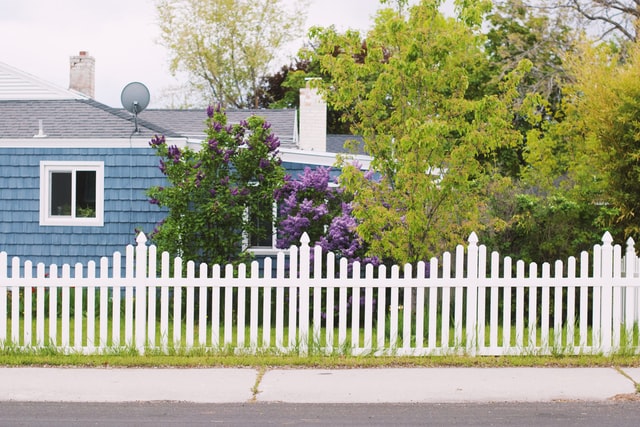How to fence a corner house
Ask yourself why you want to put up a fence before you do so. You can definitely get away with a simple chain-link fence if it’s just utilitarian, keeping the dog in the yard. You’ll want something big and substantial if you want to prevent noise or provide seclusion. Your wishes are probably complicated: You want to keep your dogs safe while also adding an aesthetic accent to the front of your house. A fence may serve a variety of purposes, but the first step is to figure out what you’re looking for so you can choose one that suits your needs.
The Right Way to Approach Your Fence
Make sure you know which way a wooden fence should face if you’re creating a privacy fence. The fence should face the neighbour on the smooth, polished side. The interior side should have the rails and posts exposed. This is how most backyard fences are constructed.
Fence Materials to Think About
A white picket fence is classic, but before you go out and buy wood posts and whitewash, consider the commitment you’re about to make. Wooden fences may need staining or sealing from time to time, and they can distort and decay. Consider a low-maintenance material like vinyl, which has the look of wood but requires less effort. Aluminum, steel, wrought iron, and bamboo are all other possible materials.
Look into the Real Estate Line
You must determine where a fence should be installed. Get your property surveyed to ensure that you’re building your fence entirely on your own land and not on the land of your neighbour. A surveyor’s document that identifies a property’s boundaries and rights of way is called a property survey. You might be able to obtain a copy of your property survey from your county’s records office if you’ve misplaced it.
Recruit experts.
Although fence installation is more difficult than it appears, the American Fence Association makes it simple to choose a local fence professional. If you opt to employ a professional, inquire about previous fence installations. Licensed businesses and individuals are usually bonded and insured, so hire them. To obtain a comprehensive idea of how the firms stand up against one another, request three to six quotations from contractors.
Think about it:
Concrete anchors are required for fence posts in frigid northern climes where frost is a factor. To prevent cracking during a cold spell, fasten the post 36 inches deep. Because wood is subject to water damage in warmer, wetter regions, vinyl is the ideal material to use. The most durable fences in extremely cold areas include wood, bamboo, and metal.
Entrances are made
Plan at least two ways into the gated area for safety and convenience. Make sure one of these can fit large items like lawn mowers and trash cans. Gates can be indicated with stepping stones, pergolas, and other aesthetic components.
Make it seem nice
Decorative posts or finials can be added to your fence after it is installed. You may wish to paint the fence a modern colour, depending on the design of your property. For a genuinely welcome facade, put a row of flowers in front of it. To create a vibrant wall of colour, mount plant hanger hooks to a wood fence and insert pots filled with annuals.
On the side of a home, where do you start the fence?
Fencing can begin anywhere along the house’s side, although some locations may be more effective than others. The following are a few things to think about: On the side of the house, there is room for a trashcan. Many individuals, on the other hand, benefit from something more substantial than well-placed trees and plants, something that may offer security and seclusion. Maintaining aesthetics and lines of sight while providing residents with this seclusion may be a tricky balancing act.
Privacy Fences: What Are They and How Do They Work?
Hedges:
Why construct a barrier when one can be grown? Starting from scratch may take a decade or more, to put it simply. If a home already has a hedge, though, there may be no need to add anything further. Arborvitae, privet, holly, and boxwood are all wonderful candidates for a hedge barrier if you’re prepared to wait for your hedge to grow. Hedges that turn the corner can be lovely, but the amount of labour required to keep them from being out of hand is another disadvantage.
Wood:
In the American landscape, this is the most common form of fence. A wooden security fence may be both a beautiful architectural feature and a practical one, since it is made up of posts, horizontal rails, and vertical slats that can be combined in virtually endless ways. The most significant disadvantage of a wooden fence is that it must be maintained on a regular basis in order to remain secure and appealing. Nails will need to be hammered back in, posts will need to be rebuilt, and the slats will need to be coated and stained or painted to protect them from moisture and the sun at some point. Wood, on the other hand, is frequently an excellent option for a corner lot since it can take the ground on one side being higher than the other.
Steel with Infill:
Steel rail and picket fences with hardwood or composite boards connected in between the pickets are a relatively new concept in residential fencing, essentially transforming a basic black steel security fence into a privacy fence. While older steel fences were prone to rust, today’s high-quality steel fencing comes with a protective coating or many protective coatings in the finest systems that make it the ideal form of fencing for a moist region. Steel or a mix of steel and wood, on the other hand, makes a wonderful fence on a busy corner since it lends a feeling of firmness to the property boundary and has a lovely, traditional aesthetic.

